Brachoria sheari
Shear’s Mimic Millipede
Paul MarekCharacteristics
Brachoria sheari individuals are about 46.4 mm long and 11.1 mm wide (females 46.8 mm X 11.4 mm). Color: 3-spotted yellow (10YR 3/14, shown above) or red (8.5R 5/14, rare, shown above); and 4-spotted yellow (i.e., with paranotal, metatergal, and prozonal spots).

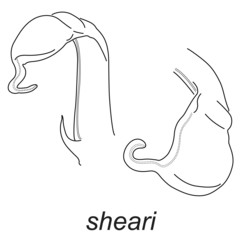
Brachoria sheari genitalia - left male gonopodal acropodite (with setae removed): (Left) medial view and (Right) magnified apical view. © Paul Marek

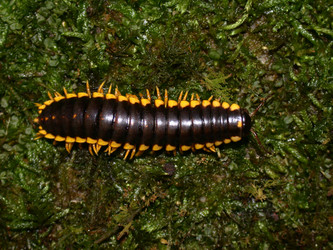
Brachoria sheari, 3-spotted yellow color morph with very faint medial metatergal spots. © Paul Marek

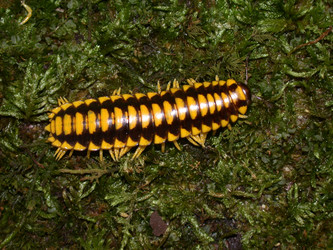
Brachoria sheari, 4-spotted yellow color morph. © Paul Marek
Habitat
Brachoria sheari specimens were collected during the day (12:06) in a forest comprising maple, sycamore, dogwood, oak, and buckeye trees. Individuals were found beneath layers of decomposing leaf material at the bottom of a dry streambed just east of the trail. Other xystodesmids encountered sympatrically at these localities are Brachoria cedra, B. dentata, and Apheloria virginiensis corrugata. Note: Individuals of B. sheari may easily be confused in the field with B. cedra, B. dentata, and A. virginiensis corrugata due to very strong similarity in color patterns.Distribution
Known only from four localities on Cumberland Mountain: two sites very close to each other on the Virginia side (in Lee Co.) of the mountain at its base, one from the Ridge Trail on top of the mountain, and another on the Kentucky side of the mountain near Shillalah Creek (Bell Co., Kentucky). The closest known Brachoria species, B. cedra and B. dentata, co-occur with B. sheari and share a strong mimetic resemblance. This species was provisionally referred to as Brachoria species “n” in Marek and Bond (2009).Conservation status
Brachoria sheari is threatened by habitat loss due to agriculture (especially growing demand for paper products), coal mining, development, and the invasion of exotic species.References
Marek P.E. 2010. A revision of the Appalachian millipede genus Brachoria Chamberlin, 1939 (Polydesmida: Xystodesmidae: Apheloriini). Zool. J. Linn. Soc. 159: 817-889.
Marek P.E., Bond J.E. 2009. A Müllerian mimicry ring in Appalachian millipedes. Proc. Nat. Acad. Sci. USA 106: 9755-9760.
Title Illustrations

| Scientific Name | Brachoria sheari |
|---|---|
| Location | USA, Virginia, Lee Co. |
| Reference | Marek P.E. 2010. A revision of the Appalachian millipede genus Brachoria Chamberlin, 1939 (Polydesmida: Xystodesmidae: Apheloriini). Zool. J. Linn. Soc. 159: 817-889. |
| Specimen Condition | Live Specimen |
| Sex | m |
| Life Cycle Stage | adult |
| View | dorsal |
| Collection | FMNH |
| Type | holotype |
| Collector | Paul Marek |
| Image Use |
 This media file is licensed under the Creative Commons Attribution-NonCommercial License - Version 3.0. This media file is licensed under the Creative Commons Attribution-NonCommercial License - Version 3.0.
|
| Copyright |
© Paul Marek

|
| Scientific Name | Brachoria sheari |
|---|---|
| Location | USA, Virginia, Lee Co. |
| Reference | Marek P.E. 2010. A revision of the Appalachian millipede genus Brachoria Chamberlin, 1939 (Polydesmida: Xystodesmidae: Apheloriini). Zool. J. Linn. Soc. 159: 817-889. |
| Specimen Condition | Live Specimen |
| Sex | f |
| Life Cycle Stage | adult |
| View | dorsal |
| Collection | FMNH |
| Type | paratype |
| Collector | Paul Marek |
| Image Use |
 This media file is licensed under the Creative Commons Attribution-NonCommercial License - Version 3.0. This media file is licensed under the Creative Commons Attribution-NonCommercial License - Version 3.0.
|
| Copyright |
© Paul Marek

|
About This Page
Work on the millipede Tree of Life pages was supported by a U.S. National Science Foundation Doctoral Dissertation Improvement Grant to Paul Marek and Jason Bond (DEB 0607996) and a Partnerships for Enhancing Expertise in Taxonomy Grant to Petra Sierwald, Jason Bond, and William Shear (DEB 0529715).
Paul Marek

Virginia Polytechnic Institute and State University
Correspondence regarding this page should be directed to Paul Marek at
Page copyright © 2010 Paul Marek
 Page: Tree of Life
Brachoria sheari . Shear’s Mimic Millipede.
Authored by
Paul Marek.
The TEXT of this page is licensed under the
Creative Commons Attribution-NonCommercial License - Version 3.0. Note that images and other media
featured on this page are each governed by their own license, and they may or may not be available
for reuse. Click on an image or a media link to access the media data window, which provides the
relevant licensing information. For the general terms and conditions of ToL material reuse and
redistribution, please see the Tree of Life Copyright
Policies.
Page: Tree of Life
Brachoria sheari . Shear’s Mimic Millipede.
Authored by
Paul Marek.
The TEXT of this page is licensed under the
Creative Commons Attribution-NonCommercial License - Version 3.0. Note that images and other media
featured on this page are each governed by their own license, and they may or may not be available
for reuse. Click on an image or a media link to access the media data window, which provides the
relevant licensing information. For the general terms and conditions of ToL material reuse and
redistribution, please see the Tree of Life Copyright
Policies.
- First online 16 September 2010
- Content changed 16 September 2010
Citing this page:
Marek, Paul. 2010. Brachoria sheari . Shear’s Mimic Millipede. Version 16 September 2010 (under construction). http://tolweb.org/Brachoria_sheari/144812/2010.09.16 in The Tree of Life Web Project, http://tolweb.org/




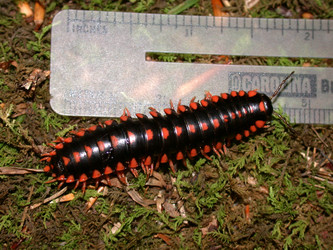
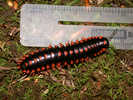


 Go to quick links
Go to quick search
Go to navigation for this section of the ToL site
Go to detailed links for the ToL site
Go to quick links
Go to quick search
Go to navigation for this section of the ToL site
Go to detailed links for the ToL site